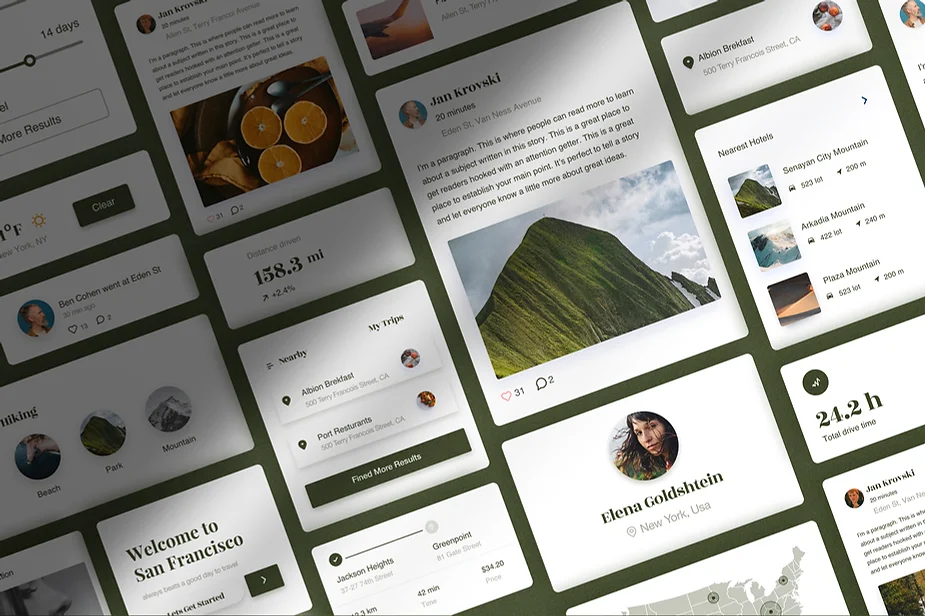Imagine having a groundbreaking idea for an app, one that has the potential to revolutionize an industry or solve a common problem. You’re excited about its potential, but you’re also aware of the challenges involved in bringing that idea to life. How do you ensure that your app not only meets the needs and expectations of your target audience but also stands out in a highly competitive market? This is where app prototyping comes into play.
In this article, we will delve into the world of app prototyping and explore how it can be a game-changer in transforming your ideas into successful products. We’ll take you on a journey through the various stages involved in creating an app prototype, from crafting a solid project plan to designing an intuitive user interface. Along the way, we’ll provide valuable insights and practical tips to help you navigate this process with confidence.
The Power of an App Prototype: Transforming Ideas into Successful Products
In the dynamic world of app development, where ideas are abundant and competition is fierce, the power of an app prototype cannot be underestimated. It serves as a transformative tool that takes a mere concept and shapes it into a successful product that resonates with users. A well-crafted app prototype bridges the gap between imagination and reality, allowing developers to visualize, refine, and validate their ideas.
By creating an app prototype, developers can bring their vision to life early in the development process. This not only provides a tangible representation of their idea but also allows for experimentation and iteration. With each iteration, the prototype evolves, becoming more refined and aligned with user needs. Ultimately, this iterative process leads to better designs, strengthened functionality, and improved user experiences.
Crafting a Solid Project Plan: Setting the Foundation for Success
Creating a successful app prototype requires meticulous planning and a solid project plan that lays the foundation for triumph. A well-crafted project plan serves as a roadmap, guiding your team towards accomplishing goals and achieving milestones. It involves defining the scope of the project, outlining deadlines, estimating resources, and determining key deliverables.
When crafting your project plan, it is crucial to prioritize tasks based on their importance and dependencies. This enables efficient resource allocation and ensures that critical elements are addressed first. Additionally, identifying potential risks early on allows for effective risk mitigation strategies to be put in place.
A well-structured project plan not only fosters clarity and direction but also instills confidence in stakeholders by showcasing your commitment to success. By setting realistic expectations and clearly defining roles and responsibilities within the team, you create an environment conducive to productivity and collaboration.
Understanding Your Target Audience: The Key to User-Centric Design
When embarking on the journey of app development, understanding your target audience is a pivotal step that cannot be overlooked. To create a successful app prototype, you must delve deep into the minds and hearts of the individuals who will ultimately determine its fate. By grasping their needs, desires, and pain points, you can craft an experience that resonates with users on a profound level.
Truly understanding your target audience involves more than just studying demographics or conducting surveys. It requires immersing yourself in their world, empathizing with their struggles and aspirations. Imagine being able to anticipate exactly what your users desire before they even realize it themselves! This level of insight allows you to design an app prototype that exceeds expectations and leaves users craving for more.
Building Personas: Getting to Know Your Users on a Personal Level
When it comes to creating a successful app, understanding your users is paramount. Building personas allows you to delve into the minds and motivations of your target audience, enabling you to create an app that deeply resonates with their needs and desires.
Personas are fictional representations of your ideal users, based on in-depth research and real data. By giving these personas names, backgrounds, and even personal goals, you humanize the user experience design process. This approach helps you empathize with your users and develop an intimate understanding of their preferences, behaviors, and pain points.
Imagine crafting an app for fitness enthusiasts. You might create a persona named “Active Anna,” who is a busy professional juggling work-life balance while striving for a healthy lifestyle. Understanding Anna’s motivations and challenges allows you to design features that seamlessly integrate into her daily routine while providing the motivation she needs.
Building personas not only fosters empathy but also aids in decision-making throughout the app development process. From feature prioritization to visual design choices, referring back to your personas ensures alignment with user expectations.
Inspired by real user insights gathered during the persona-building process, you can create an app that feels tailor-made for each individual user. By investing time into building personas, your app will have the power to forge deep connections with its users from the very first interaction.

Nailing the Software Architecture: Creating a Stable and Scalable Foundation
In the realm of app development, the software architecture serves as the backbone that supports the entire structure. Just like building a sturdy house, a stable and scalable foundation is crucial for long-term success. When it comes to nailing the software architecture, meticulous planning and thoughtful decision-making are essential.
One of the key considerations in creating a robust software architecture is selecting the right technology stack. Choosing programming languages, frameworks, and libraries that align with your project requirements can greatly impact its stability and scalability. Additionally, designing an efficient database schema that optimizes data retrieval and storage is paramount. By carefully organizing relationships between entities while considering future expansion, you can ensure a solid foundation for your app’s growth.
Designing a Seamless User Interface: Enhancing the User Experience
In the realm of app development, a seamless user interface serves as the gateway to an exceptional user experience. It is the art of combining aesthetics, usability, and functionality in a harmonious symphony that leaves users enchanted and craving more. Designing such an interface requires meticulous attention to detail, understanding the psychology behind human interaction with digital products, and a dash of creative brilliance.
The user interface design process begins by understanding your target audience’s needs and preferences. By conducting extensive research, you can delve into their desires, pain points, and expectations. Armed with this knowledge, you can then start sketching wireframes to visualize how different elements will be arranged on each screen. Every button placement, color choice, font selection – they all play a crucial role in dictating how users perceive and navigate your app.
The Art of UX: Creating Intuitive and Delightful Interactions
In the realm of app development, the user experience (UX) is paramount in determining the success of a product. The art of crafting intuitive and delightful interactions lies at the core of creating an app that users will not only embrace but also cherish. UX design focuses on understanding users’ needs, behaviors, and emotions to deliver a seamless and engaging experience.
To create such interactions, designers must employ a combination of empathy, creativity, and problem-solving skills. They must put themselves in the shoes of their users, anticipating their desires and providing them with intuitive solutions. By carefully considering every touchpoint within an app – from the navigation flow to button placements and micro-interactions – designers have the power to transform a mundane experience into one that captivates users.

Tackling the Database Schema: Organizing and Managing Your Data
Behind every successful app lies a robust and well-organized database schema. This critical component serves as the backbone of your application, ensuring efficient data storage, retrieval, and management. A meticulously designed database schema not only enhances performance but also allows for scalability, adaptability, and future-proofing.
When tackling the database schema for your app prototype, it is essential to consider factors such as data integrity, security, and ease of use. Start by identifying the core entities within your application and their relationships. Map out the tables, fields, and relationships that will best represent your data structure.
Optimize query performance by carefully selecting indexes to speed up database operations. Consider implementing normalization techniques to eliminate redundancy and maintain data consistency. Additionally, incorporate security measures such as encryption algorithms for sensitive information.
Remember that a well-organized database schema not only improves performance but also simplifies maintenance and facilitates future enhancements or integrations seamlessly. By investing time in crafting an efficient schema during the prototyping phase, you set your app on a path to success.
Bringing Your App to Life: Creating an Interactive Prototype
Now that you have meticulously planned your app and gained a deep understanding of your target audience, it’s time to bring your creation to life through an interactive prototype. This critical phase bridges the gap between conceptualization and implementation, providing you with a tangible representation of your app’s functionality.
Creating an interactive prototype involves crafting a user interface that not only looks stunning but also mirrors the intended user experience. With every tap, swipe, or scroll, users should feel a sense of excitement and engagement as they navigate through your app. By focusing on intuitive navigation and seamless interactions, you’ll leave users with a lasting impression that ignites their enthusiasm for what your app has to offer.
Testing, Iterating, and Refining: Perfecting Your Prototype for Success
Once you have a functional app prototype, the real journey begins. Testing, iterating, and refining are crucial steps in transforming your prototype into a polished product that resonates with your target audience. Embracing this process wholeheartedly will pave the way for success.
Testing is the compass that guides your development journey. Conduct comprehensive usability tests to gather valuable feedback from users. Evaluate their interactions with the prototype and analyze their pain points and preferences. This invaluable insight will serve as a roadmap for refining your app’s design and functionality.
The beauty of iterations lies in their ability to transform an already impressive prototype into something truly extraordinary. Use the feedback from your tests to identify areas that need improvement or enhancement, whether it’s the user interface, user experience flow, or overall performance. Embrace each iteration as an opportunity to push boundaries, fine-tune details, and elevate your app to new heights.

Conclusion: Embrace the Power of App Prototyping for Success
In conclusion, embracing the power of app prototyping is a crucial step on the path to success in the digital landscape. By carefully crafting a solid project plan, understanding and empathizing with your target audience, and meticulously designing every aspect of your app’s user interface and experience, you are laying the foundation for triumph. With each iteration and refinement made possible through testing and feedback, you are inching closer to a product that not only meets users’ needs but also delights them. So, seize this opportunity to transform your ideas into reality through app prototyping – for the potential rewards are limitless in this ever-evolving digital world.
